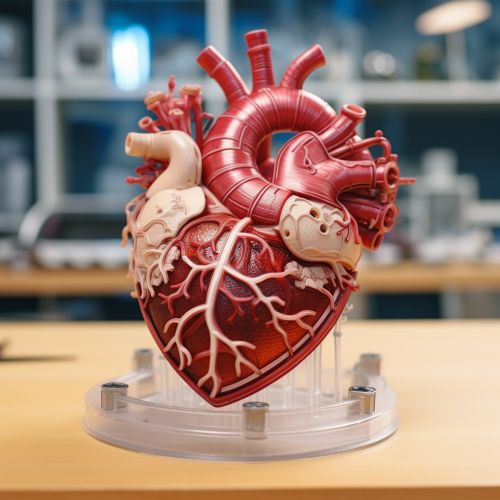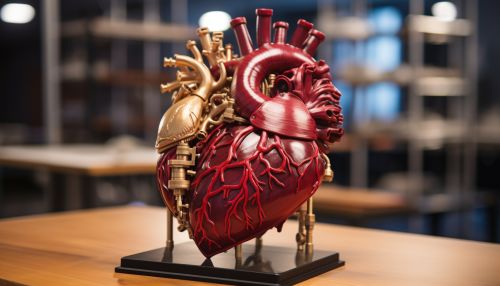Congenital heart defects
Overview
Congenital heart defects (CHDs) are abnormalities in the heart's structure that are present at birth. They are the most common type of birth defect and can affect the heart walls, heart valves, and blood vessels. There are numerous types of CHDs, some of which are simple and don't require treatment, while others are complex and may require multiple surgeries performed over a period of several years.


Classification
Congenital heart defects can be classified into several types based on the specific structure of the heart that is affected. These include septal defects, outflow tract defects, cyanotic heart defects, and others. Each of these categories encompasses a range of specific conditions, each with its own set of symptoms, treatment options, and prognoses.
Septal Defects
Septal defects are the most common type of CHD, accounting for approximately one-third of all cases. These defects involve a hole in the septum, the wall that separates the left and right sides of the heart. The two main types of septal defects are atrial septal defects (ASDs) and ventricular septal defects (VSDs).
Outflow Tract Defects
Outflow tract defects involve abnormalities in the large blood vessels that carry blood from the heart to the rest of the body. These defects can affect the aorta, the main artery that carries oxygen-rich blood from the heart to the body, or the pulmonary artery, which carries oxygen-poor blood from the heart to the lungs. Examples of outflow tract defects include coarctation of the aorta and pulmonary stenosis.
Cyanotic Heart Defects
Cyanotic heart defects are a group of CHDs that result in a decrease in the amount of oxygen in the blood. This leads to a blue or purple coloration of the skin, lips, and nail beds, a condition known as cyanosis. Examples of cyanotic heart defects include tetralogy of Fallot and transposition of the great arteries.
Causes and Risk Factors
The exact cause of most congenital heart defects is unknown. However, certain genetic conditions, maternal health factors, and environmental exposures during pregnancy have been identified as potential risk factors.
Genetic Factors
Certain genetic conditions, such as Down syndrome and Turner syndrome, are associated with an increased risk of CHDs. In addition, some CHDs are thought to be caused by mutations in specific genes. However, in most cases, the genetic cause of the defect is unknown.
Maternal Health Factors
Certain maternal health conditions and behaviors during pregnancy can increase the risk of having a baby with a CHD. These include diabetes, obesity, smoking, and the use of certain medications or illicit drugs.
Environmental Exposures
Certain environmental exposures during pregnancy, such as to certain chemicals or infections, can also increase the risk of CHDs. However, the specific exposures that are associated with an increased risk of CHDs are not well understood.
Diagnosis
Congenital heart defects can often be diagnosed before birth through the use of prenatal screening tests, such as an ultrasound. After birth, a CHD may be suspected if a baby has symptoms such as rapid breathing, bluish skin, or a heart murmur. Further diagnostic tests, such as an echocardiogram or a cardiac catheterization, may then be performed to confirm the diagnosis and determine the specific type and severity of the defect.
Treatment
The treatment of congenital heart defects depends on the type and severity of the defect. Some defects, particularly simple ones, may not require any treatment. Others can be treated with medications, procedures performed using a cardiac catheter, or surgery. In some cases, a combination of treatments may be used.
Medications
Medications can be used to treat symptoms of CHDs, such as heart failure or high blood pressure. They can also be used to prevent blood clots or to control heart rhythm problems.
Cardiac Catheter Procedures
Some CHDs can be treated using procedures that are performed using a cardiac catheter. These procedures involve inserting a thin tube, or catheter, into a blood vessel and guiding it to the heart. Once the catheter is in place, it can be used to repair the defect.
Surgery
Surgery may be required to repair more complex CHDs. In some cases, multiple surgeries may be needed over a period of several years. The specific type of surgery that is performed depends on the type and severity of the defect.
Prognosis
The prognosis for individuals with congenital heart defects varies widely, depending on the type and severity of the defect, the presence of other health conditions, and the timing and effectiveness of treatment. With advances in diagnosis and treatment, many individuals with CHDs now survive into adulthood and can lead healthy lives.
